15 September 2025
517
18 min
0.00
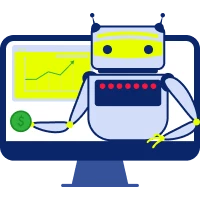
AI-Powered Personalized Marketing: What AI Technologies eCommerce Leaders Use
Content
Today ecommerce business operates under conditions of limited budgets, high competition, changing demand, and high audience expectations. Teams are constantly looking for tools that allow them to effectively develop marketing strategies, attract and retain more customers, reduce operational costs, and optimize employee performance.
Today, one such solution is AI. This is not just an auxiliary tool, but a real growth engine that helps optimize marketing, qualitatively personalize and transform customer experience, increase customer loyalty, and ultimately strengthen the company's position in the market. According to McKinsey, 78% of businesses are already actively using AI in at least one business function. According to the company's forecasts, more and more will integrate AI into various structures and processes. Regarding customer acquisition and retention—currently 56% of marketers actively use AI in their work, and this number is actively growing.
In this article, we share practical insights on AI application in marketing: from generative tools that create personalized content to predictive models that forecast customer behavior and preferences. The tools mentioned in the article are implemented and supported by the Yespo platform, used by Eastern European retailers such as adidas, PUMA, Liki24, Foxtrot, Dnipro.m, Prom, Shafa, Stylus, and 4,000 other brands with a total of 23 million customers.
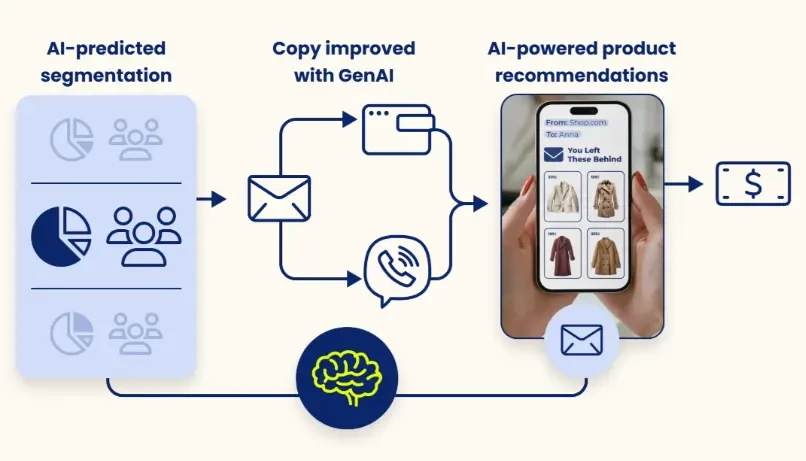
The Impact of AI Use on eCommerce Marketing
The impact of artificial intelligence on business largely depends on industry specifics, chosen tools, and the depth of their integration. Companies that actively invest in AI not only allocate resources and are ready to experiment, but also usually achieve the highest effect. According to McKinsey research, organizations that apply AI can increase revenues by 3-15% and improve sales profitability by 10-20%. AI provides opportunities for:
- Efficient use of team resources. AI performs routine tasks, freeing up marketers' time for strategic planning and testing new ideas.
- Budget optimization. AI ensures relevant interaction with interested customer groups, reduces irrelevant communications, and accelerates return on investment.
- Risk reduction of errors. Compared to manual processes, algorithms have higher accuracy, minimizing errors through clear templates and machine learning.
- Increased competitiveness. Deep customer understanding allows personalizing communication at all stages of the sales funnel, contributing to increased customer loyalty.
- Improved forecasting accuracy. AI identifies trends and patterns in customer behavior, allowing more accurate prediction of their next actions, product demand, and campaign effectiveness.
- Reduced cart abandonment rate. Algorithms identify barriers that stop customers, enabling marketers to adjust interaction and configure subsequent campaigns.
Generative AI: Content Creation and Automation
Generative AI is used to create content—texts, images, audio, video—based on input data and conditions. It forms original materials that didn't exist before. Such content helps increase audience interest, improve brand impression, and automate processes that take up 60-70% of employees' time.
Generative AI tools that reduce routine work and ensure high-quality output content:
1. Email Text Optimization
With AI, you can quickly process texts and formulate precise messages. For example, integrated AI in Yespo's email editor allows creating texts, shortening or expanding them, translating them into 10+ languages, checking grammar, changing tone of voice, and improving subject lines with preheaders.
Companies can create texts faster and adapt them to the needed segment, while global brands can additionally make instant campaign translations without losing meaning.
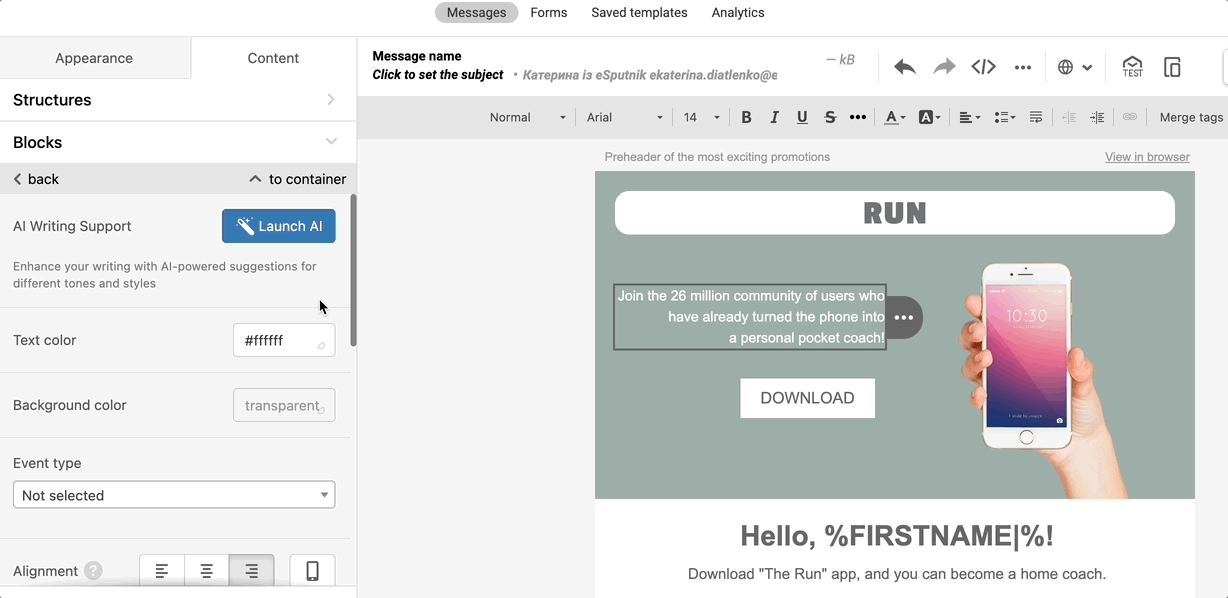
2. Automatic Block Filling in Emails
Block filling in emails—generative AI automatically processes content from sources, filling modules. Simply drag a module from the library and paste a product page link—AI independently fills the block: adds product description, images, and links, speeding up email creation by up to 50%.
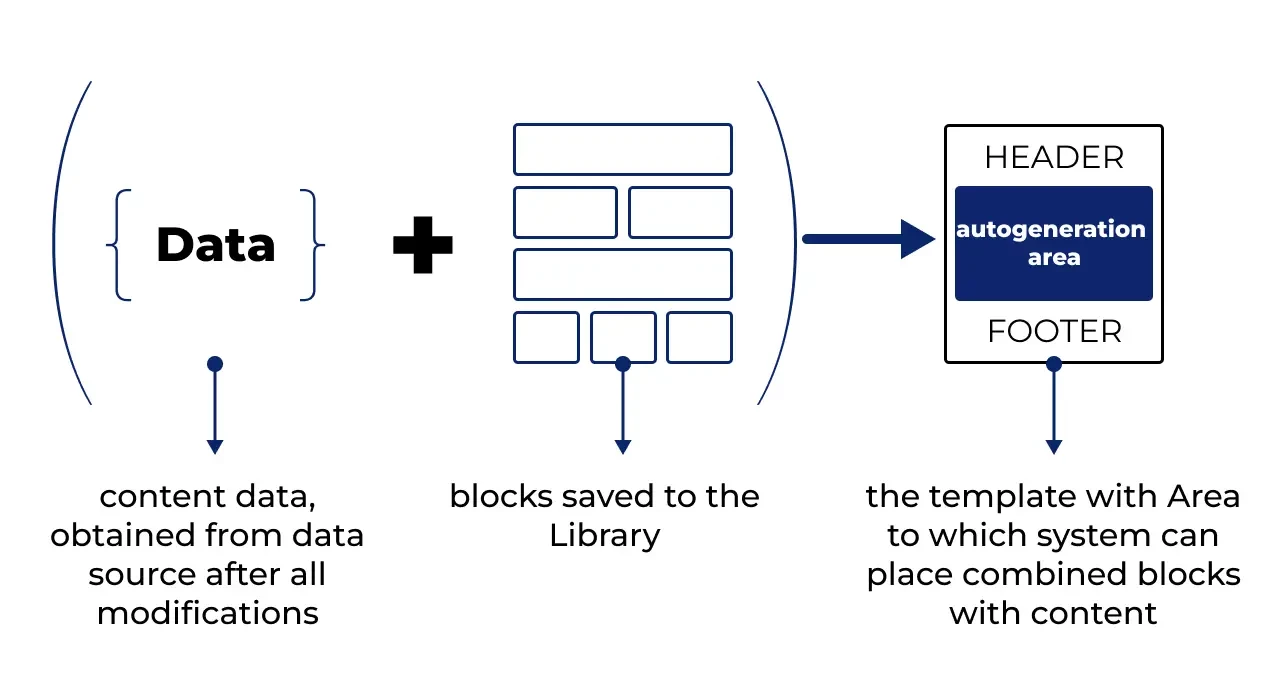
Mobile Push Generation
AI quickly creates headlines and texts for pushes based on mobile app data automatically pulled from the store and the specified message topic, adapting them to segments for maximum engagement.
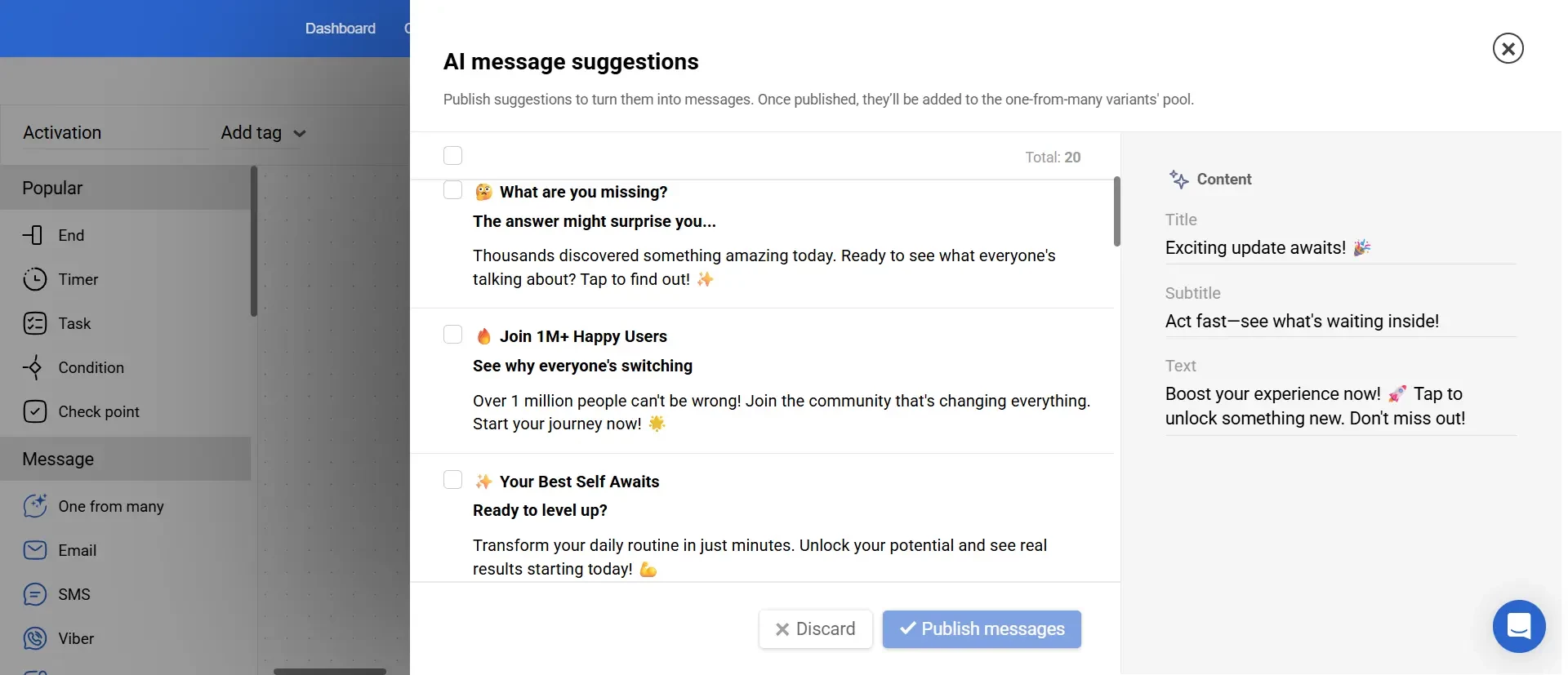
Mobile Campaign Workflow Generation and Filling
AI creates entire campaigns for segments (new, active, registered users) based on the goal specified by the marketer (conversion, engagement, retention). As a result, AI generates: campaign description and duration, step-by-step workflows with message texts, explanations, and benchmarks for effectiveness analysis.
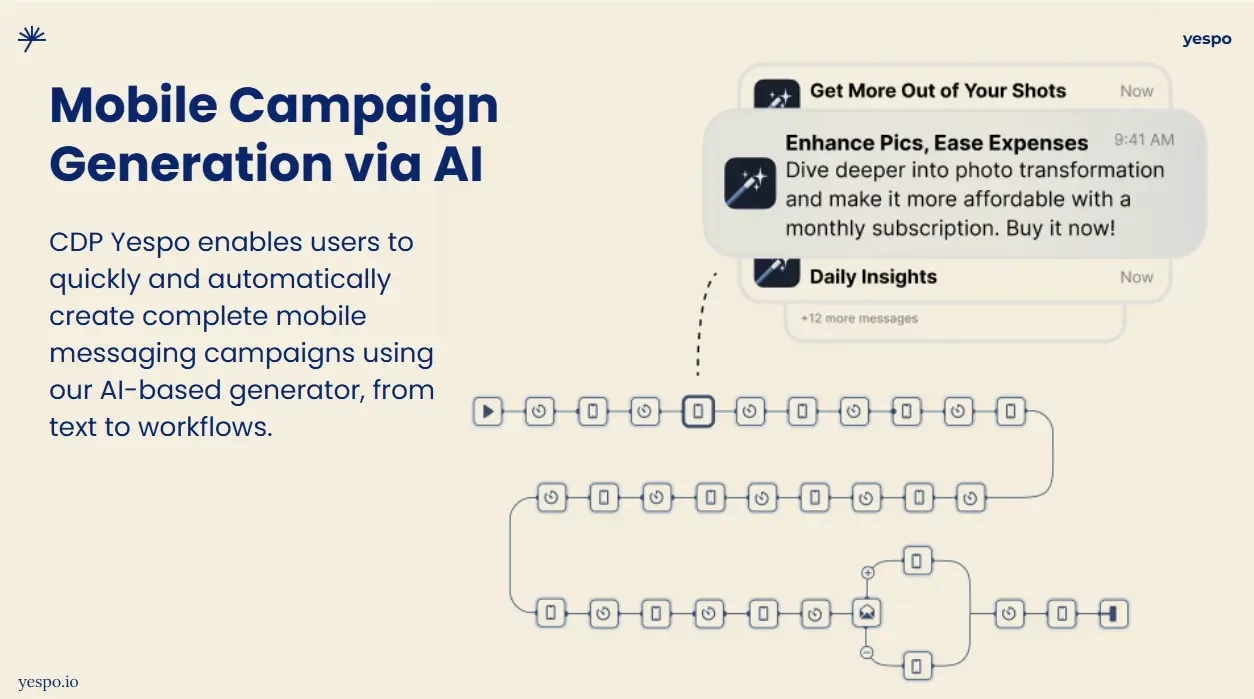
Continuous A/B Testing
Classic A/B testing with fixed groups works for clean experiments but is slow: a campaign must run from several days to weeks for a marketer to evaluate results. During this time, part of the audience receives the worse variant.
Continuous testing, implemented by the "One of Many" block in Yespo, can optimize campaigns instantly. The system sends different email variants to several segments (equal in audience size) → automatically determines the best variant → sends it further.
Marketers can add new message variants at any time, and the block automatically integrates them into testing. Also, AI built into the editor can independently create messages, allowing testing of marketer creativity versus artificial intelligence.
This saves time on campaign preparation, as marketers don't need to manually create separate workflow branches or stop the process to analyze results.
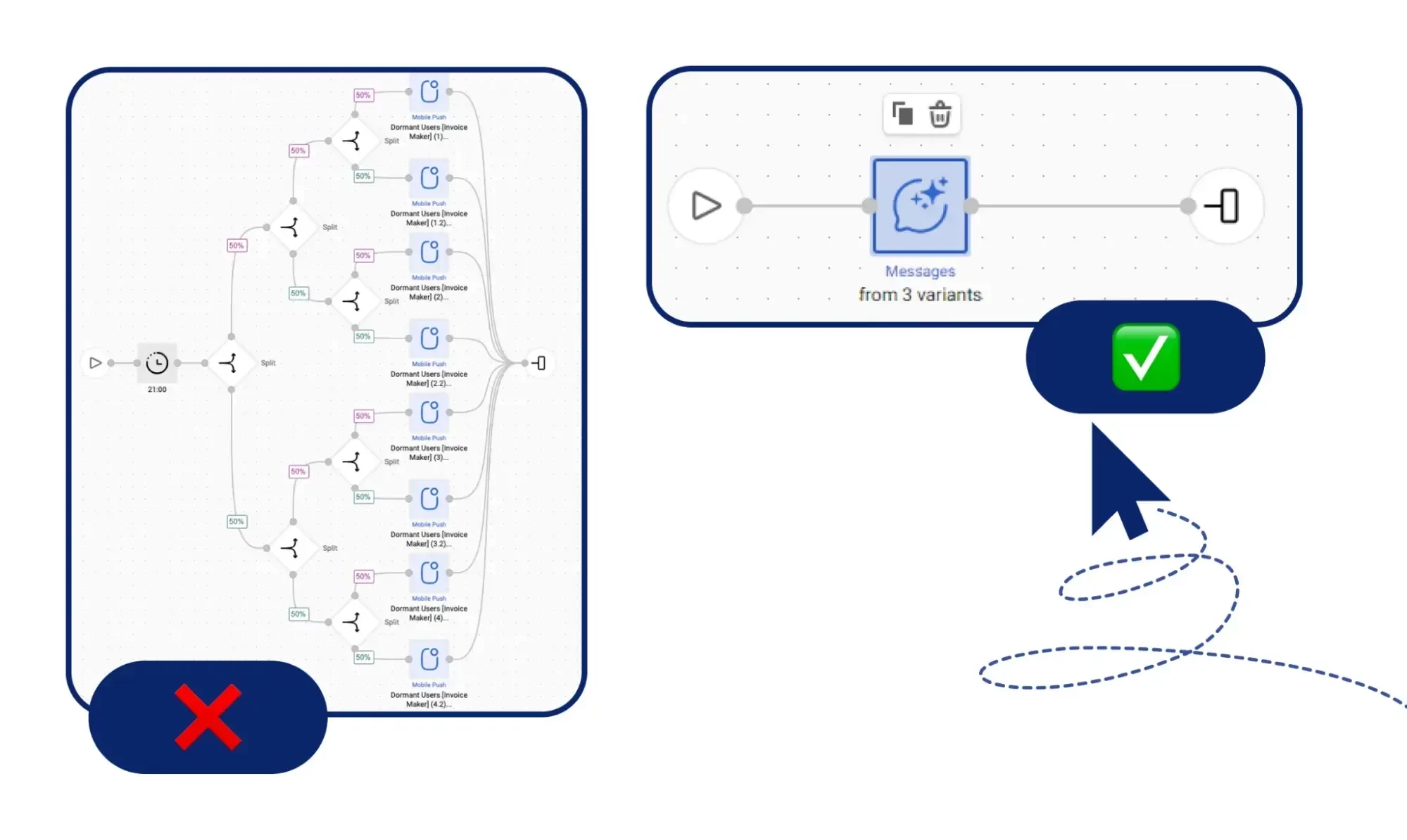
For example, Prom.ua used this tool to reduce the number of users who viewed products through the app but didn't make purchases. Thanks to this, notification clicks increased by 26%, and mobile push sales conversion increased by 5%.
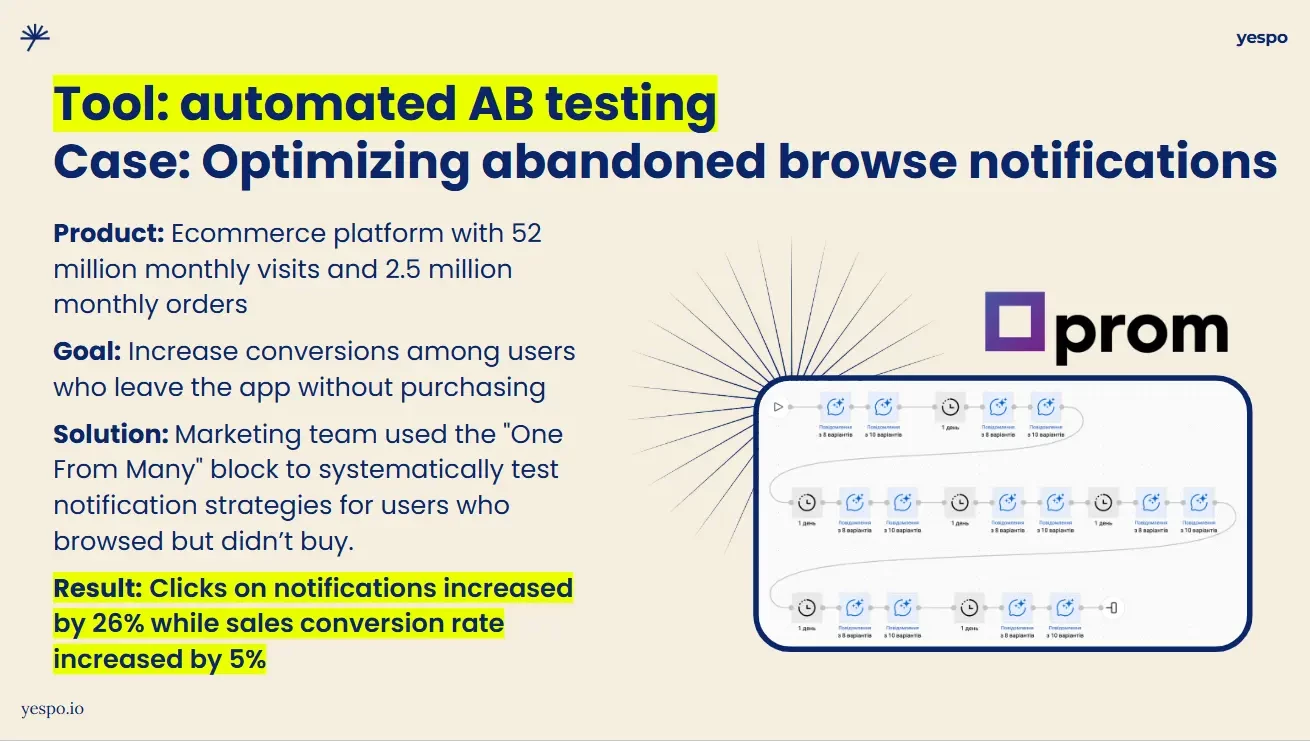
A similar task was faced by the ANC pharmacy network: increase conversion among users who added products to cart but didn't make purchases. The "One of Many" block was used to test message texts and automatically determine the most effective variant. As a result, they achieved +23% to average order value and doubled mobile push traffic.
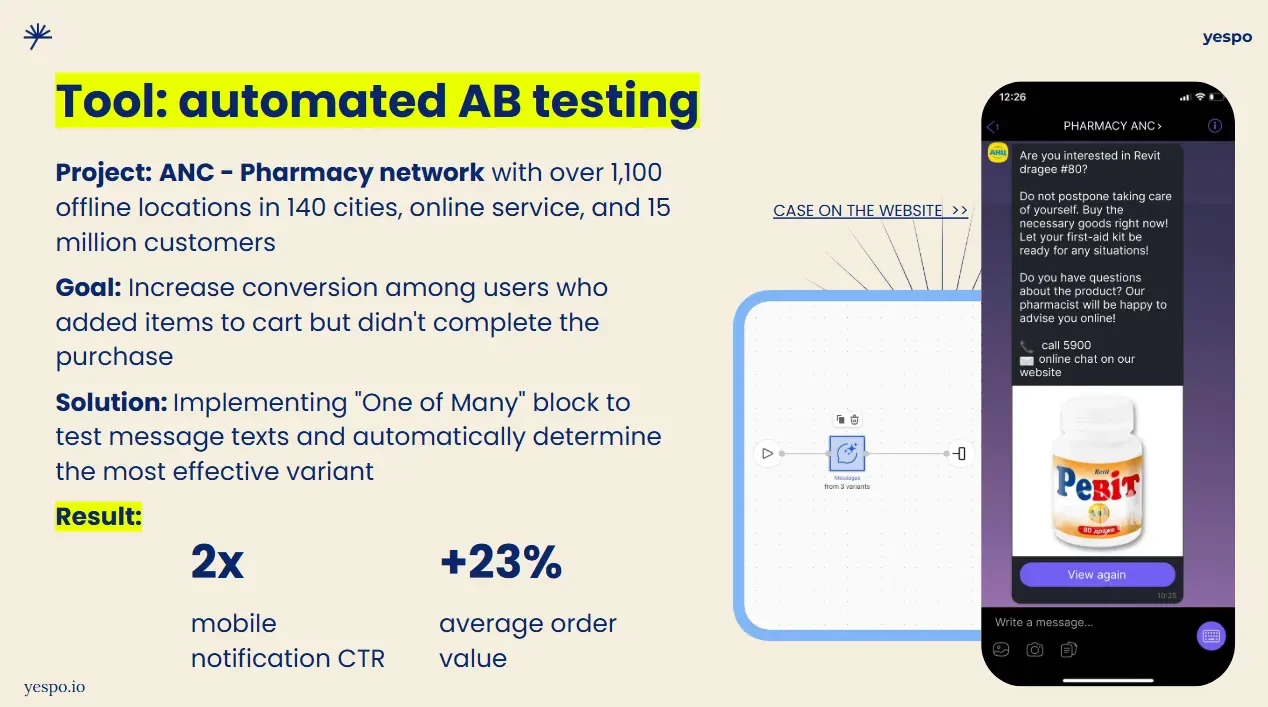
Predictive AI: Forecasting Future Customer Actions and Purchases
Predictive AI analyzes historical data to forecast future events, identify dependencies in customer behavior, and make informed decisions. This allows providing a quality personalized experience to each user, ultimately leading to increased sales, average order value, and customer retention. According to statistics, companies using AI-based personalization report 25% sales growth compared to companies not using it.
Let's examine effective personalization tools working on predictive AI:
1. Personal Product Recommendations: AI Knows What Your Customers will Buy
Today, when consumers are overwhelmed by choice, 74% simply close the website, and unsuccessful purchases lead to returns, logistics costs, and loyalty loss. The worst scenario is when dissatisfied customers choose a competitor who can satisfy their needs. After all, 91% of people are more likely to buy from companies that personalize their experience. One effective tool for this is product recommendations.
The goal of product recommendations is to suggest exactly those products that will most likely interest the customer, leading to a purchase.
How AI algorithms built into CDP manage to select products that customers want to buy with 69% accuracy:
- Data collection about customer actions from the website, app, direct channels, and offline.
- Information unification and enriching a unified contact profile with it.
- Data processing and analysis using deep learning AI. This technology increases recommendation accuracy and effectiveness by identifying hidden connections between users and products.
- Recommendation generation considering data about:
- Behavior—how users interact with products (views, clicks, purchases);
- Customer—demographics, geolocation, preferences (e.g., clothing size, wishlist items);
- Products—price, category, brand.
- Omnichannel application of ready recommendations: on website, in app, in direct channels (email, push, App Inbox, Viber).
The more customer data available to algorithms and the faster it updates, the more accurate the recommendations will be. An omnichannel approach ensures a continuous customer experience regardless of the brand interaction channel.
New Level of Personalization: Transformers and Large Language Models (LLM)
Yespo CDP has been creating product recommendations for over 12 years. During this time, we've developed and tested over 200 recommendation formation algorithms and made them available in the platform. Usually, this tool increases website conversion by 20-30%, with a record result for one of our clients being +60%.
We constantly work on improving functionality, with typical annual performance gains of +5-10%. It seemed that significantly improving algorithm effectiveness was no longer possible. However, two years ago, a real breakthrough occurred.
Yespo CDP is one of the first platforms in Ukraine to combine transformer neural network architecture (better known to everyone as Chat GPT), Large Language Models, and recommendation models.
Using transformers enables deeper analysis of user behavior and preferences, while large language models added the ability to analyze product characteristics: categories, brands, prices, descriptions.
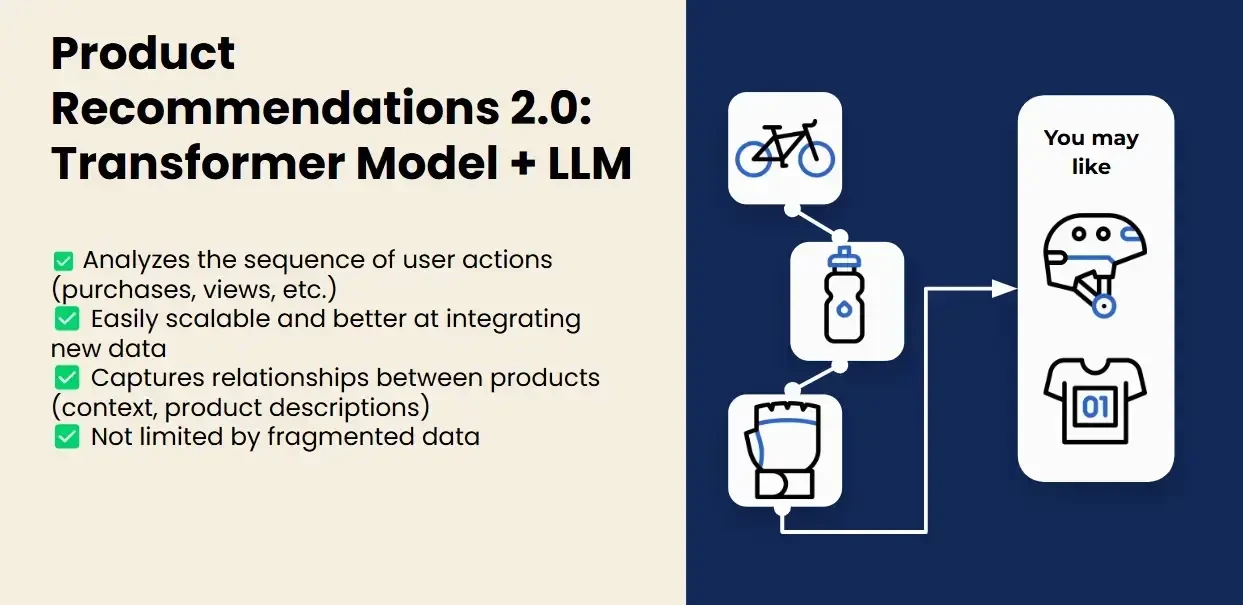
Previously, algorithms were limited to connections between products—for example, a smartphone case or a sports t-shirt to pants from the same manufacturer. Now AI analyzes the entire customer journey: every click, viewed page, wishlist item, completed purchase—considered in the context of user actions. The system understands the essence of products, not just their SKU (Stock Keeping Unit): algorithms can work with limited data, for example, with new products or those no one has bought yet. Thus, the system provides a better understanding of both customers and products, so it can form maximally relevant product recommendations.
The first to test the updated algorithms was Ukraine's largest omnichannel retailer “Foxtrot”, and achieved:
- +33%—growth in recommendation block CTR;
- ×2.08 traffic increase—for the “Personally for you” block.
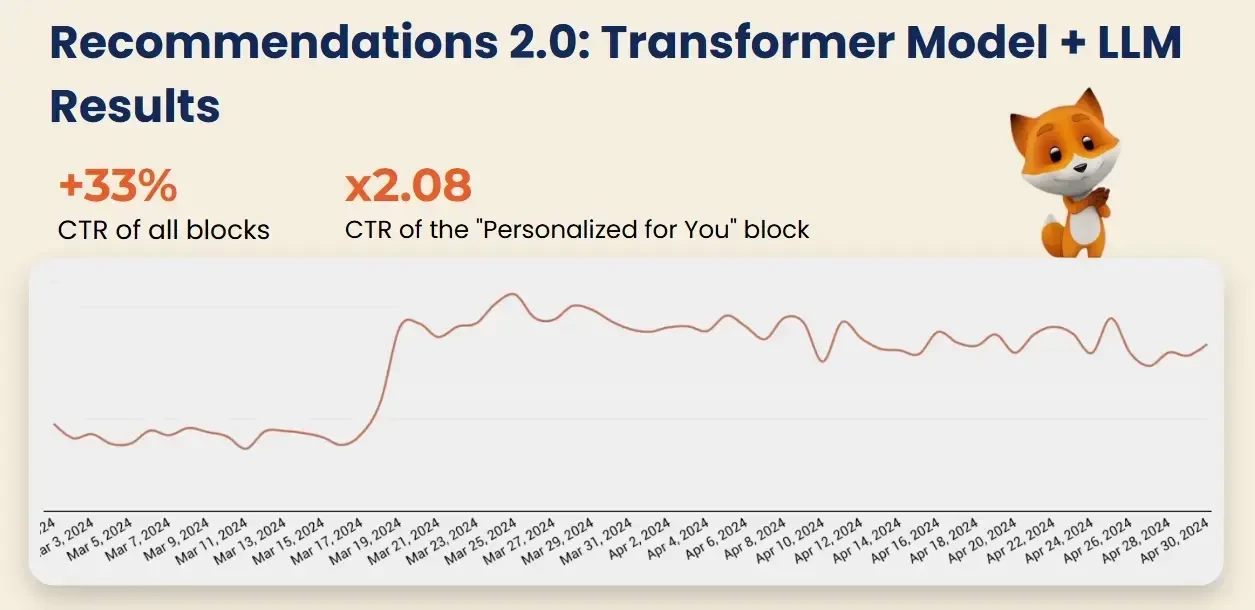
The updated algorithms showed impressive results within just a few months of operation.
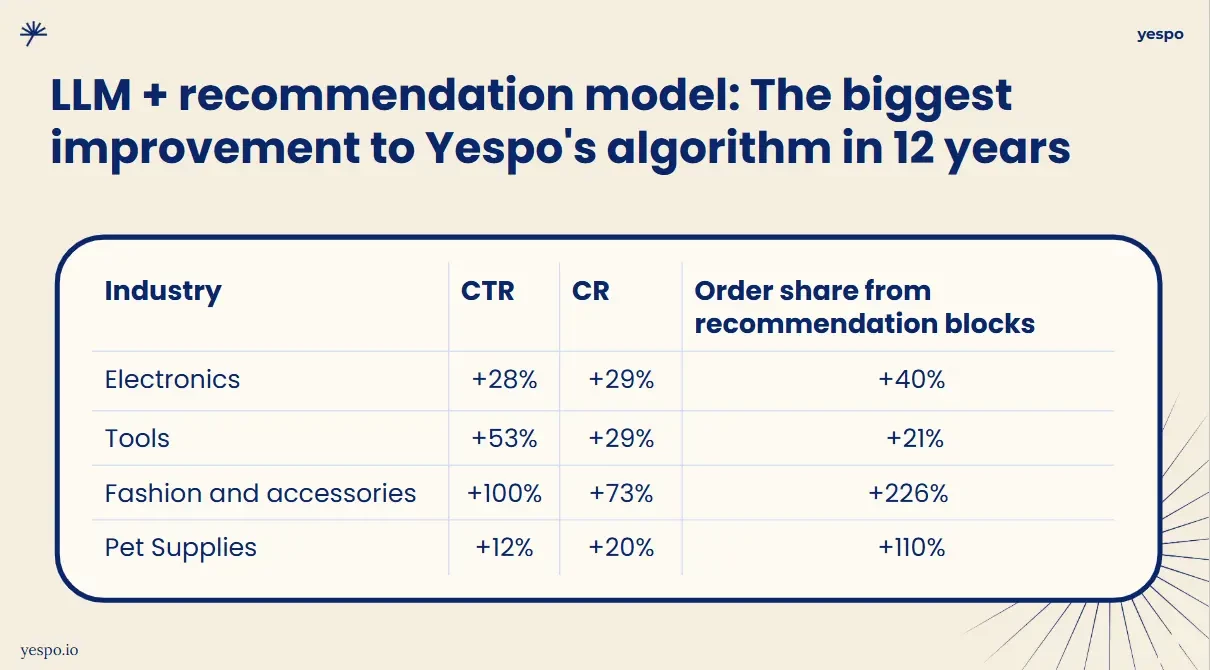
But the website is not the only customer interaction point where business uses product recommendations. They're available: in apps, direct channels (Email, App Inbox, Web Push, Mobile Push, widgets, Viber, Telegram bot, SMS).
Some clients went even further by implementing personal product recommendations in mass mailings. Since such emails have a large audience reach, including customized selections can multiply conversions.
For the medication search marketplace Liki24, implementing personal recommendation blocks in mass campaigns brought +70.8% to conversion, while for the Ukrainian vitamin and dietary supplement brand Perla Helsa, this indicator increased by 106%, and email channel revenue grew by 34%.
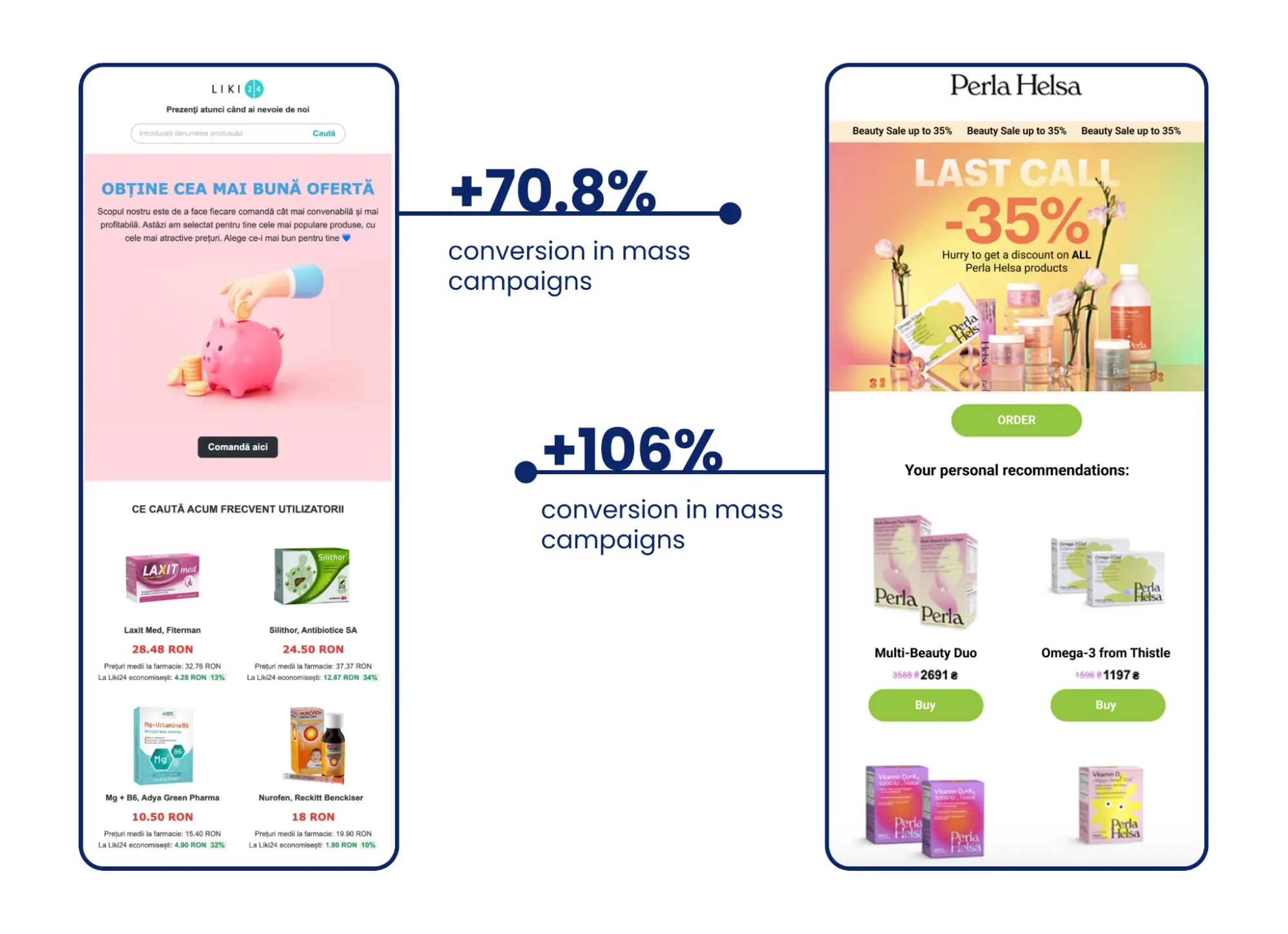
AI as Category Manager for Product Recommendations
Despite excellent results from recommendation algorithms, Yespo continues seeking ways to increase client sales. While working on transformer model implementation, the Yespo team noticed potential for improving the tool for “Foxtrot.” AI didn't select products from the same category in recommendations to avoid duplication. This limited cross-sales when there are products within one category that logically complement each other.
To solve this, we implemented an LLM model that automatically clarifies subcategories and forms correct recommendations. It analyzes the product category tree, identifies functional connections, and suggests compatible or complementary products, working almost like an experienced category manager.
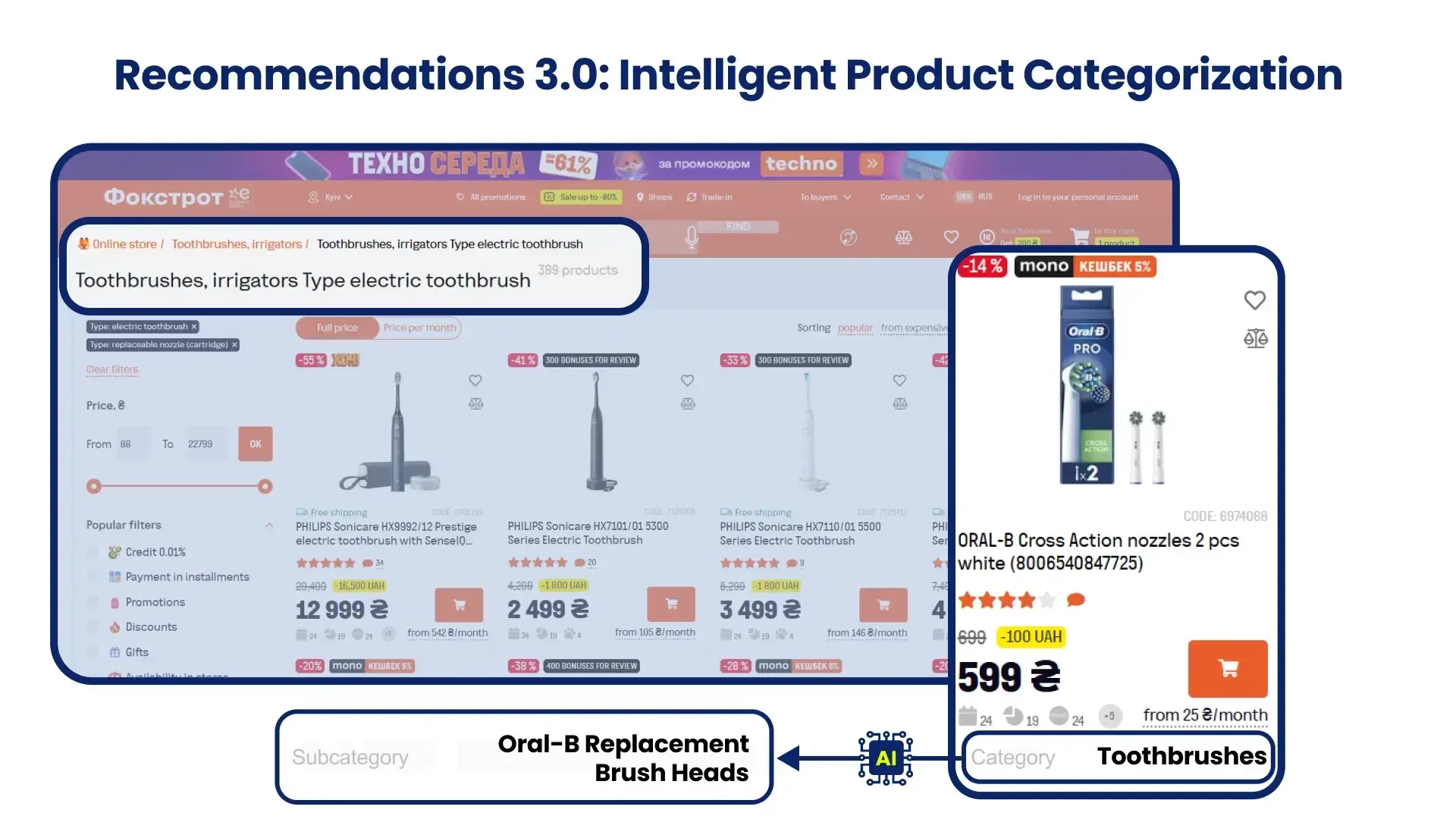
For example, in the "Toothbrushes" category, there are brushes, heads, cases, and care accessories. Thanks to recategorization, you can now suggest logical purchase additions to customers: a head or case. The system will form relevant product pairs even from the same general category, improving personalization quality and cross-sales.
Results of the "Frequently Bought Together" block (testing period March-May 2025):
- +39% to CTR;
- 1.5x growth in accessory sales.
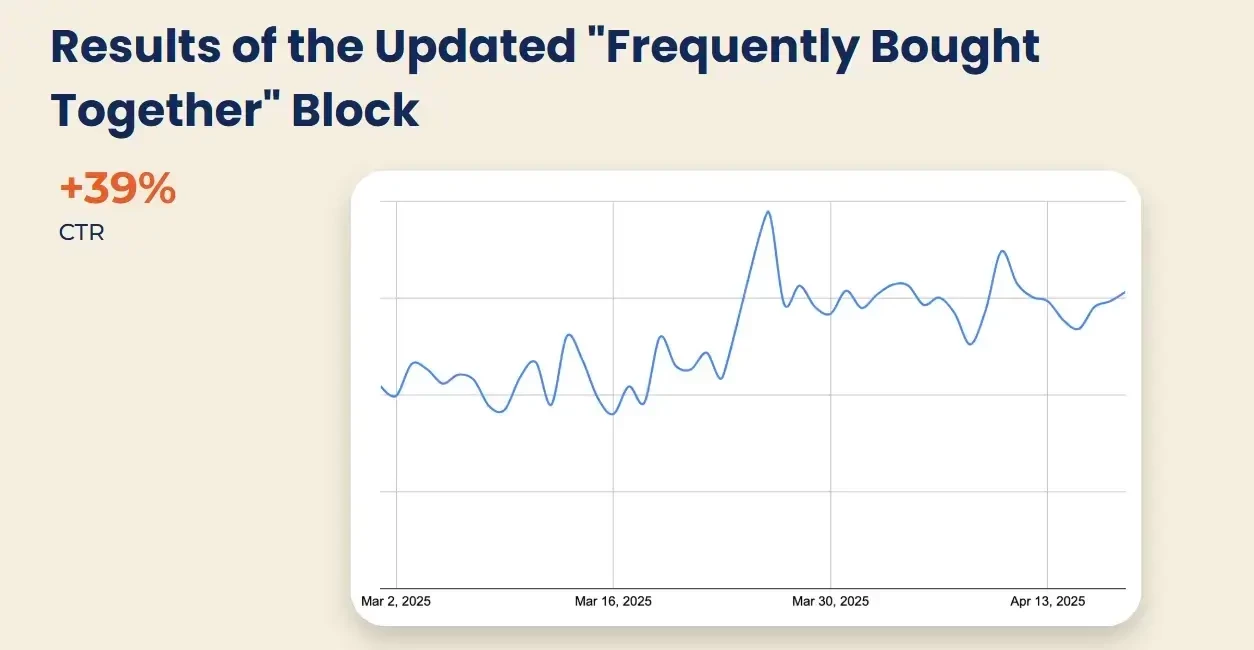
2. Predictive Segmentation: AI Knows Who Will Make a Purchase Soon
Predictive segmentation automatically identifies customer groups by purchase probability or churn risk. Unlike manual segmentation, which is limited to a certain number of conditions (usually up to 10), predictive segmentation, instead of fixed rules, analyzes thousands of patterns in audience behavior and predicts how users will act next.
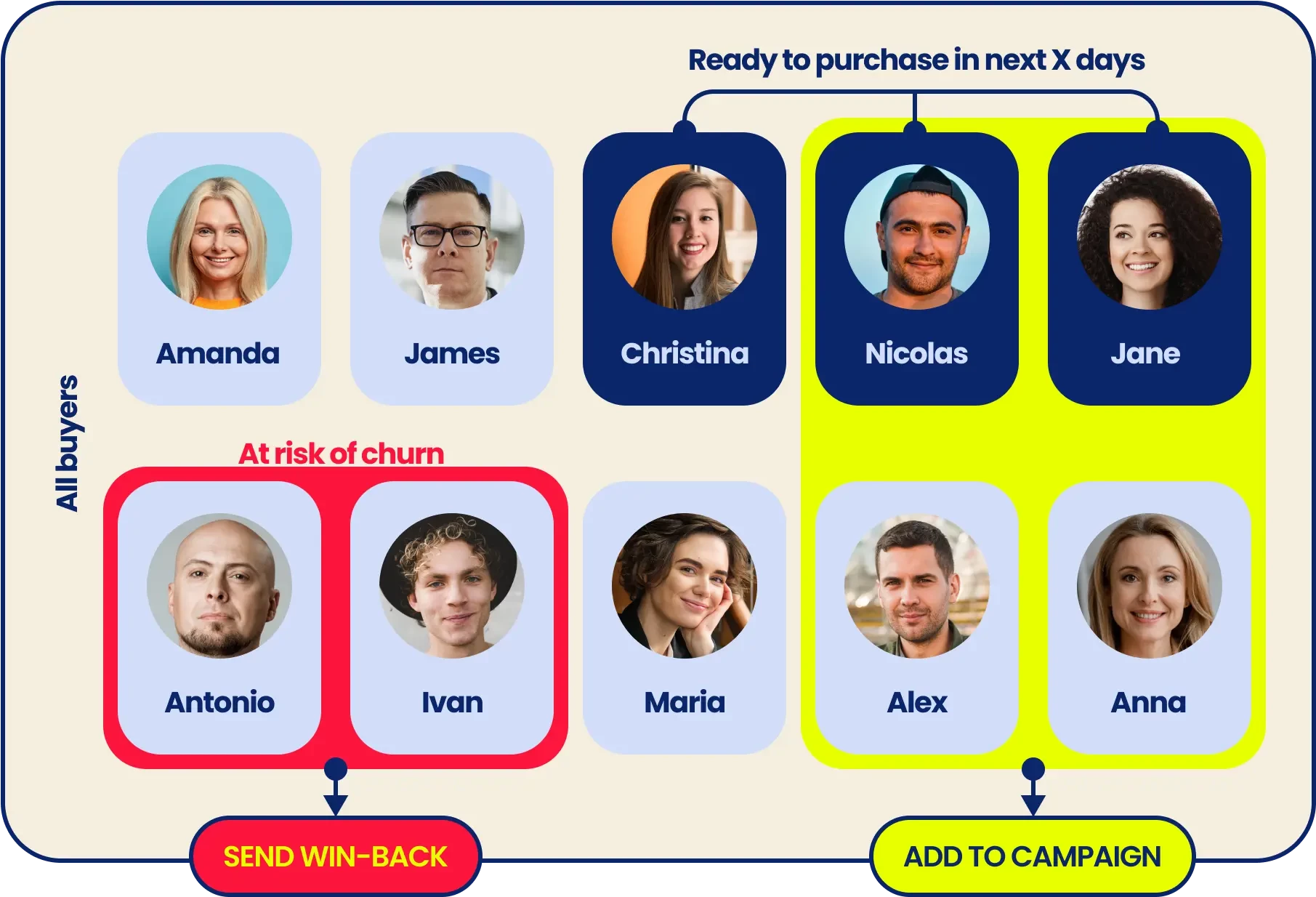
The goal of predictive segmentation is to identify users most ready to purchase, so marketers can effectively focus on promising audiences and avoid spending on irrelevant communications.
How predictive segmentation works using the CDP example:
- Data collection and structure: As with product recommendations—everything starts with data—the system accumulates and combines customer behavior data, purchase history, and demographics into a unified profile.
- Pattern analysis: AI identifies behavior patterns of customers who already made purchases and correlates this information with behavior data of other users, thus predicting their purchase readiness.
- Probability forecasting: Based on identified patterns, the system classifies users by purchase readiness level. At Yespo, we divided customers into four segments: potential buyers, guaranteed buyers, unlikely buyers, and undecided ones.
- Constant updates: The model continuously learns from new data, allowing timely campaign adaptation and offering relevant products and promotions to those most ready to act.
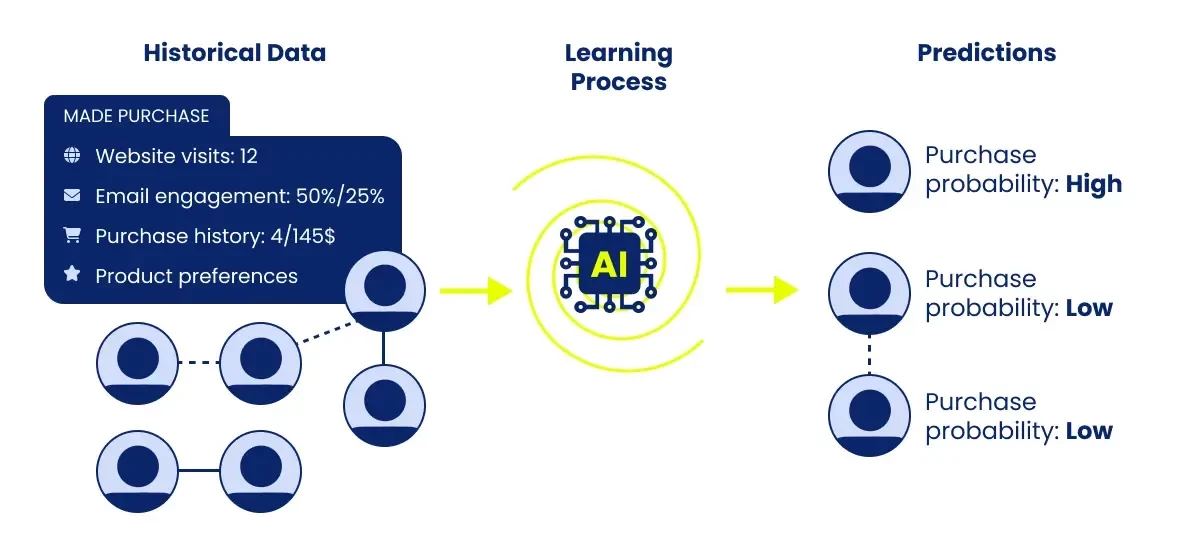
Predictive segmentation helps more precisely target marketing campaigns and increase their effectiveness with lower costs. Viber or SMS mailings to uninterested users will lead to budget loss, while these channels give good results when sending messages to guaranteed and potential buyers.
For example, Ukrainian clothing brand O.TAJE used predictive segmentation and achieved +310% ROMI for Viber mailings and +300% conversion rate.
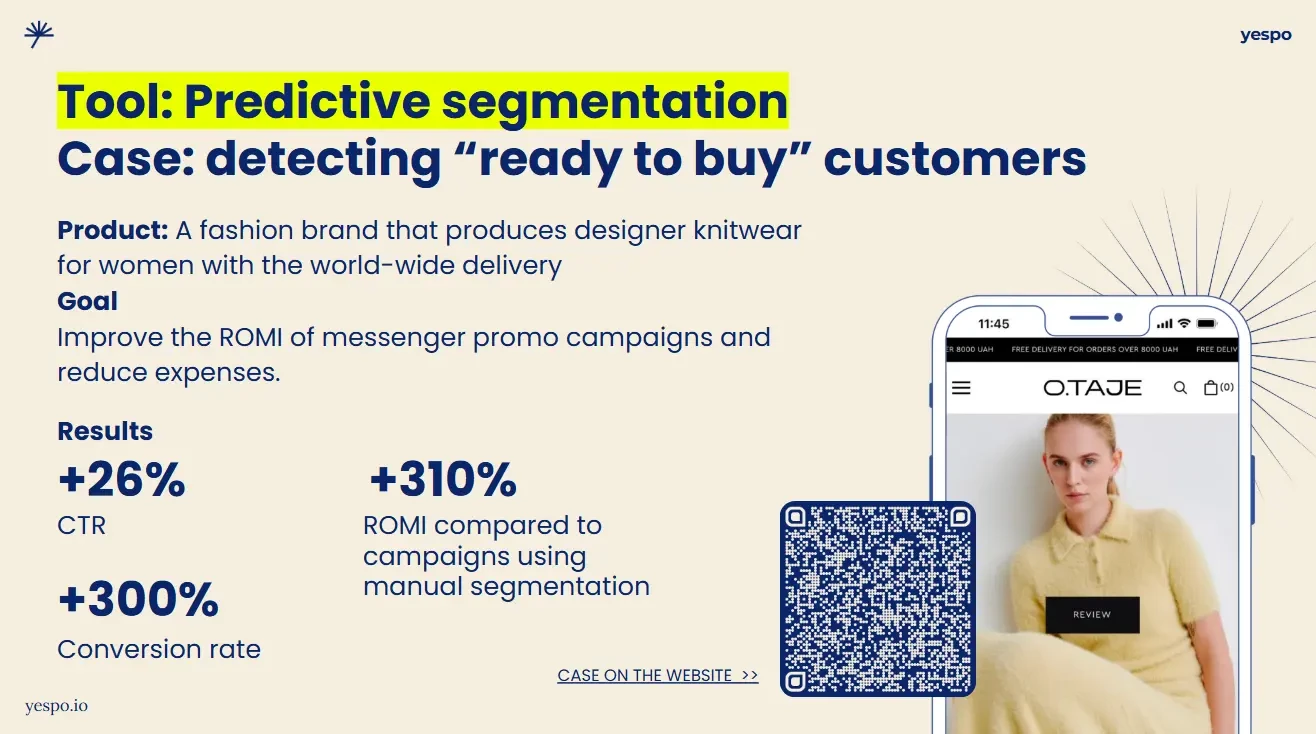
Agentic AI and How It Will Impact Marketing
AI development in marketing happened gradually: from simple rule-based automation to predictive analytics and generative artificial intelligence. Now we expect the next global AI level: agentic AI. This technology, knowing the campaign's final goal, can independently assess situations, formulate strategies, and execute them without constant supervision.
To better understand agentic AI's impact, let's consider marketing operation levels:
- Strategic—executives (CEO, CMO) define brand positioning, growth goals, and marketing budget. This requires deep understanding of business, market, and alignment with company global goals.
- Tactical—marketing managers transform strategy into plans: develop campaigns, choose channels and audience approaches, allocate resources and budgets. Strategic thinking and tactical skills are necessary at this stage. Predictive AI will be useful here: product recommendations and predictive segmentation. These tools help identify the most promising customer segments, predict their behavior, including the products they want to buy. This allows effective budget allocation for maximum ROI.
- Operational—teams implement plans: create content, visual materials, and launch campaigns. Generative AI helps increase productivity at this level.
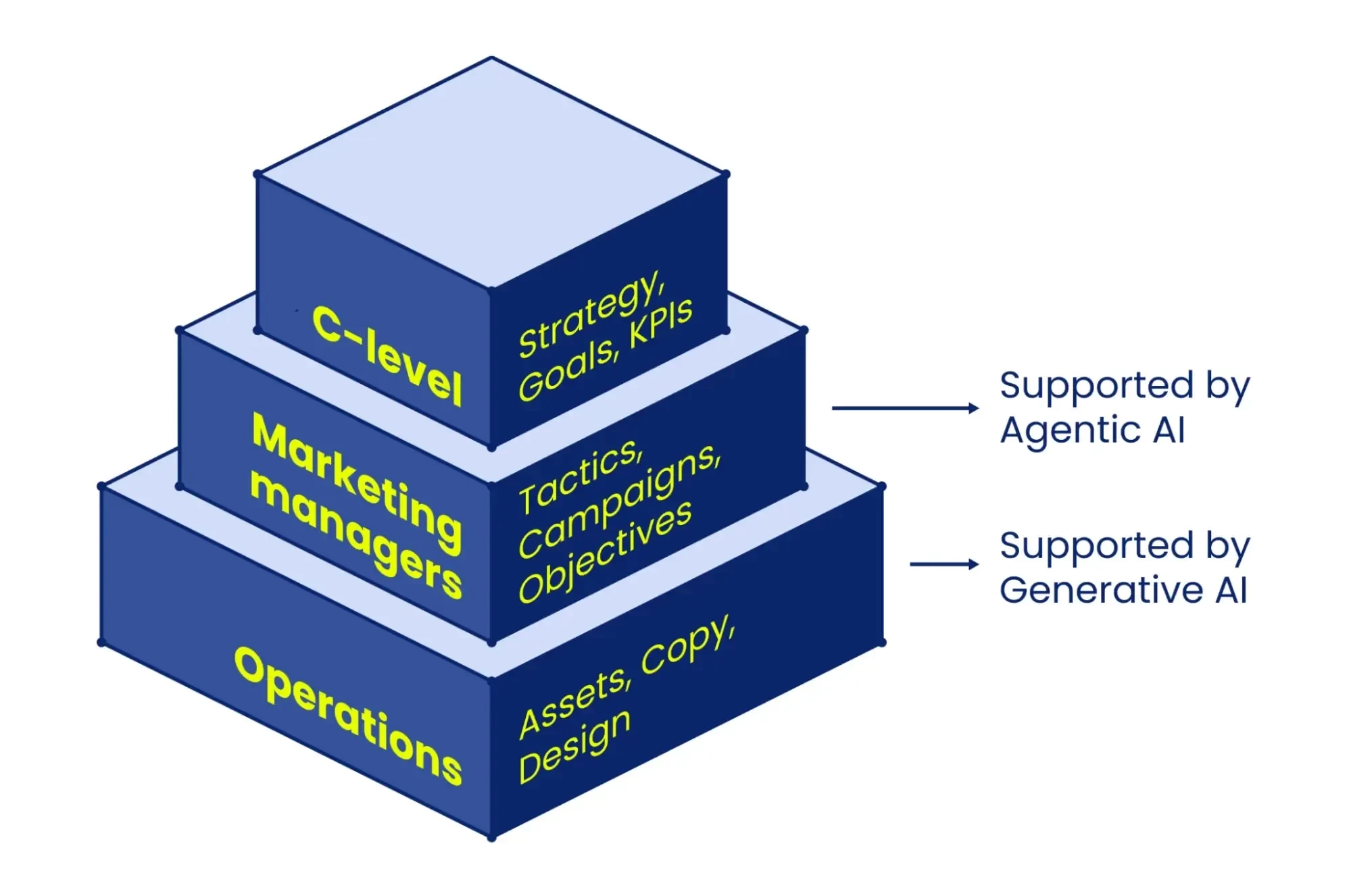
Generative AI accelerates content creation. Predictive AI influences decision-making. Agentic AI not only analyzes and predicts. It raises marketing management to another level by suggesting actions, adjusting strategy, optimizing processes, independently launching campaigns, and generating content. AI frees marketer time for greater creativity and strategic thinking, where brand value is truly formed.

Conclusions
AI already today increases conversion, AOV, and ROMI, reducing costs on ineffective actions and campaigns.
Key technologies actively applied in Ukrainian eCommerce for sales growth:
- Generative AI: automation of content creation and improvement—from email text optimization and block filling in emails to mobile push generation, mobile campaign workflow development, and continuous A/B testing.
- Predictive AI: personalized product recommendations based on transformers and LLM that analyze customer behavior, preferences, and product characteristics, plus predictive segmentation to identify customers with high purchase probability or churn risk.
Soon, businesses will test agentic AI capabilities—technology that can independently form strategies, assess situations, and perform marketing tasks without constant control.
There are indeed many technologies, and this can create uncertainty: what exactly to implement and where to start? We at Yespo CDP have been working with AI for over 12 years and see how properly selected tools bring maximum returns to business.
We want to share our experience with business, so we're currently offering free consultations. Our leading experts will help understand which AI solutions will bring the greatest benefit to your specific company and take the first step toward sustainable growth.


